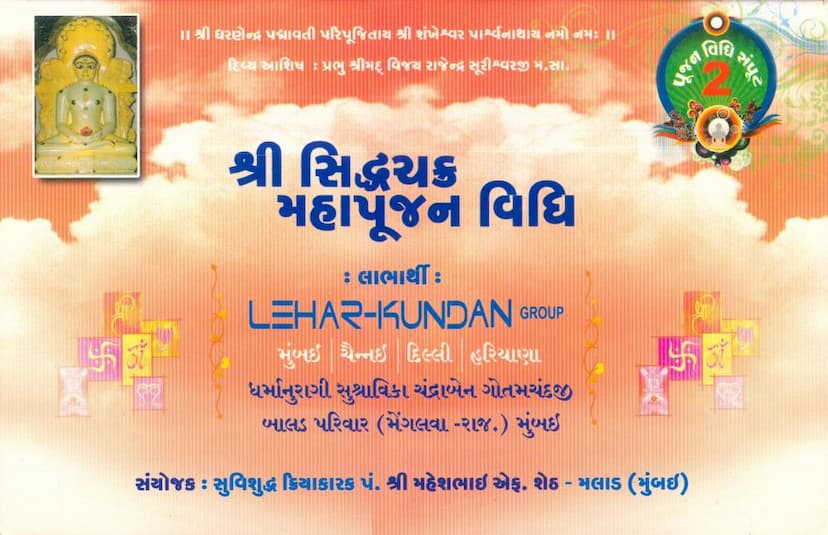Poojan Vidhi Samput 02 Siddhachakra Mahapoojan Vidhi
Added to library: September 2, 2025

Summary
This document is the "Poojan Vidhi Samput 02 Siddhachakra Mahapoojan Vidhi," a Jain ritualistic text authored by Maheshbhai F. Sheth and published by Siddhachakra Prakashan. The book is a part of a larger set of twelve books titled "Poojan Vidhi Samput" that compile various Jain rituals and ceremonies.
The "Siddhachakra Mahapoojan Vidhi" specifically details the procedure for performing the elaborate worship of the Siddhachakra, a significant diagram in Jainism representing the Nine Supreme Beings. The text emphasizes the auspiciousness and efficacy of this ritual for achieving worldly and spiritual benefits.
Key aspects and content of the book include:
- Invocation and Blessings: The book begins with invocations and blessings from religious leaders, particularly from Param Pujya Shrimad Vijay Rajendra Surishwarji Maharaj, and acknowledges the sponsors and contributors, such as the Lehar-Kundan Group and the Chandraben Gautamchandji Balad family.
- Purpose and Context: The "Prastavikam" (preface) explains the necessity of reprinting the "Poojan Vidhi Samput" due to the rapid sale of the first edition and the continuous demand from religious scholars and practitioners. It highlights the generous financial support from Shri Gautambhai Jain of "Lehar Kundan Group" for this reprint.
- Siddhachakra Yantra Description: The text provides a detailed description of the Siddhachakra Yantra, explaining its central 'Arham' (or 'A') seed, surrounded by various vowels, consonants, mantras, divine beings, and protective deities, arranged in concentric circles. It emphasizes the yantra's significance as the essence of Jainism and a path to liberation.
- Ritualistic Procedures: The book meticulously outlines the step-by-step procedures for performing the Siddhachakra Mahapoojan. This includes:
- Purification of the Space: Mantras for purifying the ritual area (e.g., invoking Vayu Kumar, Megh Kumar, and Bhoomi Devta).
- Self-Purification: Mantras and mudras for cleansing the body and mind (e.g., mantra snan, kalmash dahan, hriday shuddhi).
- Vajrapanja Stotra: A powerful stotra for self-protection before commencing the main ritual.
- Puja of the Yantra and its Components: Detailed instructions for worshipping each part of the Siddhachakra Yantra, from the central nine supreme beings (Arhat, Siddha, Acharya, Upadhyaya, Sadhu, Samyag Darshan, Samyag Gyan, Samyag Charitra, Samyag Tapa) to the various circumferences representing divine beings, protectors, deities, planets, and treasures. This involves offering specific flowers, fruits, and sweets.
- Ashta Prakari Puja: A detailed explanation of the eight types of offerings: water, sandalwood, flowers, incense, lamp, akshat (uncooked rice), naivedya (food offering), and fruits.
- Abhishekam (Bathing Ceremony): Instructions for performing the sacred bath of the Siddhachakra with various purifying substances like milk, yogurt, ghee, sugarcane juice, and scented water.
- Invocation and Installation: Mantras for inviting and installing the presiding deities of the Siddhachakra.
- Offerings to Deities: Specific procedures for worshipping various celestial beings, including the nine planets (Navagraha), ten directions (Dash Dikpal), Yakshas and Yakshinis, and the guardian deities.
- Recitation of Mantras and Stotras: Emphasis on chanting specific mantras and stotras related to the Siddhachakra and the nine supreme beings.
- Conclusion of the Ritual: Procedures for Aarti (worship with lamps), Mangal Deep (auspicious lamp), Shanti Kalash (peace urns), and finally, the process of bidding farewell to the deities (Visarjan).
- Benefits of Worship: The text describes the manifold benefits of worshipping the Siddhachakra, including the attainment of wealth, status, knowledge, health, longevity, protection from evils, and ultimately, liberation. It cites examples of individuals who achieved great spiritual and worldly boons through this worship.
- Materials Required: A comprehensive list of materials (Poojan Samagri) needed for the Mahapoojan is provided, covering everything from sacred offerings to decorative items and ritualistic implements.
- Time Allocation: An approximate time allocation for each stage of the puja is suggested, indicating the depth and duration of this elaborate ritual.
- Guidance for Performers: The text also includes information about the qualifications of the ritual performer (Kiyakarak) and acknowledges the blessings of various revered Gurus and Acharyas.
In essence, "Siddhachakra Mahapoojan Vidhi" is a practical guide for Jains to perform a highly venerated and potent ritual to connect with the divine principles represented by the Siddhachakra, seeking spiritual upliftment and worldly well-being.